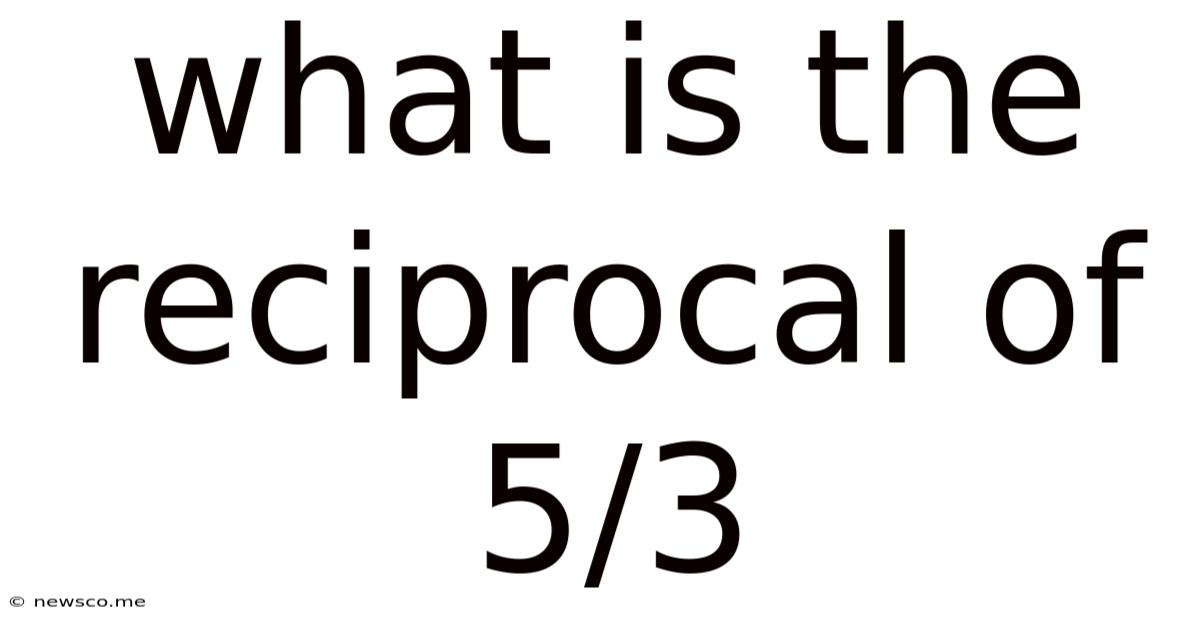What Is The Reciprocal Of 5/3
News Co
Apr 24, 2025 · 5 min read

Table of Contents
What is the Reciprocal of 5/3? A Deep Dive into Mathematical Inverses
The question, "What is the reciprocal of 5/3?" might seem simple at first glance. However, understanding reciprocals goes beyond a simple calculation; it delves into the fundamental concepts of multiplicative inverses and their applications across various mathematical fields. This article will not only answer the question directly but also explore the broader meaning of reciprocals, their properties, and their significance in mathematics and beyond.
Understanding Reciprocals: The Multiplicative Inverse
The reciprocal of a number is its multiplicative inverse. This means that when you multiply a number by its reciprocal, the product is always 1. This concept is crucial in simplifying fractions, solving equations, and performing numerous mathematical operations.
Think of it like this: a number and its reciprocal are like opposites in multiplication. Just as addition has an opposite (subtraction), and multiplication has an opposite (division), every number (except zero) has a reciprocal that “undoes” it when multiplied.
The Reciprocal of a Fraction
Finding the reciprocal of a fraction is particularly straightforward. You simply switch the numerator and the denominator. The numerator becomes the denominator, and the denominator becomes the numerator.
For example:
- The reciprocal of 2/5 is 5/2.
- The reciprocal of 7/1 is 1/7.
- The reciprocal of 1/3 is 3/1 (or simply 3).
Calculating the Reciprocal of 5/3
Now, let's answer the central question: What is the reciprocal of 5/3?
Following the rule for finding the reciprocal of a fraction, we switch the numerator and the denominator:
The reciprocal of 5/3 is 3/5.
This can be easily verified:
5/3 * 3/5 = (5 * 3) / (3 * 5) = 15/15 = 1
As expected, multiplying 5/3 by its reciprocal, 3/5, results in 1.
Beyond the Calculation: Exploring the Significance of Reciprocals
While finding the reciprocal of 5/3 is a simple arithmetic operation, understanding the broader implications of reciprocals is crucial for advanced mathematical concepts.
Reciprocals in Algebra
Reciprocals play a vital role in solving algebraic equations. Consider an equation like:
(5/3)x = 10
To solve for 'x', we multiply both sides of the equation by the reciprocal of 5/3, which is 3/5:
(3/5) * (5/3)x = 10 * (3/5)
This simplifies to:
x = 6
Without the understanding of reciprocals and their ability to cancel out terms, solving such equations would be significantly more complex.
Reciprocals in Advanced Mathematics
Reciprocals extend beyond basic algebra and are fundamental in more advanced mathematical areas like:
- Linear Algebra: Reciprocals (or inverses) of matrices are essential for solving systems of linear equations. The concept expands from simple numbers to more complex structures.
- Calculus: Reciprocals are crucial in derivative calculations and integral evaluations. Understanding their behavior is fundamental to comprehending concepts like rates of change and accumulation.
- Complex Numbers: Reciprocals also extend to complex numbers, where the reciprocal of a complex number z = a + bi is given by 1/z = (a - bi) / (a² + b²). This involves conjugates and opens up interesting geometric interpretations.
Reciprocals in Real-World Applications
The concept of reciprocals isn't confined to theoretical mathematics; it finds practical applications in various fields:
- Physics: Reciprocals are frequently used in formulas related to optics (focal length), electricity (resistance), and mechanics (speed and time).
- Engineering: Engineers use reciprocals in calculations involving gear ratios, lever systems, and other mechanical systems. The reciprocal relationship directly influences the output of these systems.
- Finance: Reciprocals can be useful in calculating return on investment (ROI) and determining growth rates. Understanding rates and their inverse relationships is crucial for economic modeling.
- Computer Science: Reciprocals are essential in various algorithms and computations. For instance, normalization and scaling often use reciprocals to ensure consistency in data analysis.
Zero and its Reciprocal: A Special Case
It's important to note that zero is the only real number that does not have a reciprocal. There is no number that, when multiplied by zero, equals one. Attempting to find the reciprocal of zero leads to an undefined result, highlighting the unique nature of zero in the number system. This is why it is critically important to note and handle cases involving division by zero to prevent computational errors.
Understanding the Relationship Between Numbers and Their Reciprocals
The relationship between a number and its reciprocal offers intriguing insights into the properties of numbers:
- Positive Numbers: The reciprocal of a positive number is also positive.
- Negative Numbers: The reciprocal of a negative number is also negative.
- Numbers Greater Than 1: The reciprocal of a number greater than 1 is a number between 0 and 1.
- Numbers Between 0 and 1: The reciprocal of a number between 0 and 1 is a number greater than 1.
- Numbers Equal to 1: The reciprocal of 1 is 1.
Observing these patterns helps solidify understanding of the relationship between numbers and their multiplicative inverses.
Conclusion: Mastering Reciprocals for Mathematical Proficiency
This in-depth exploration has revealed that the simple question, "What is the reciprocal of 5/3?" opens a door to a rich understanding of multiplicative inverses and their far-reaching significance. From basic arithmetic to advanced mathematical fields and real-world applications, the concept of reciprocals forms a cornerstone of mathematical reasoning. Mastering this concept is crucial for building a solid mathematical foundation and tackling more complex problems with confidence. Remember, the reciprocal of 5/3 is 3/5, a fact that now resonates with a much deeper mathematical understanding.
Latest Posts
Related Post
Thank you for visiting our website which covers about What Is The Reciprocal Of 5/3 . We hope the information provided has been useful to you. Feel free to contact us if you have any questions or need further assistance. See you next time and don't miss to bookmark.